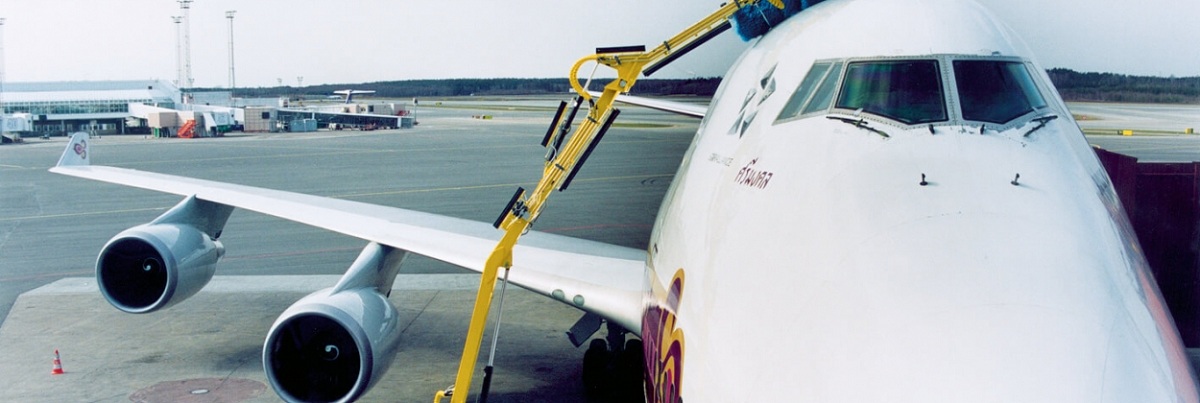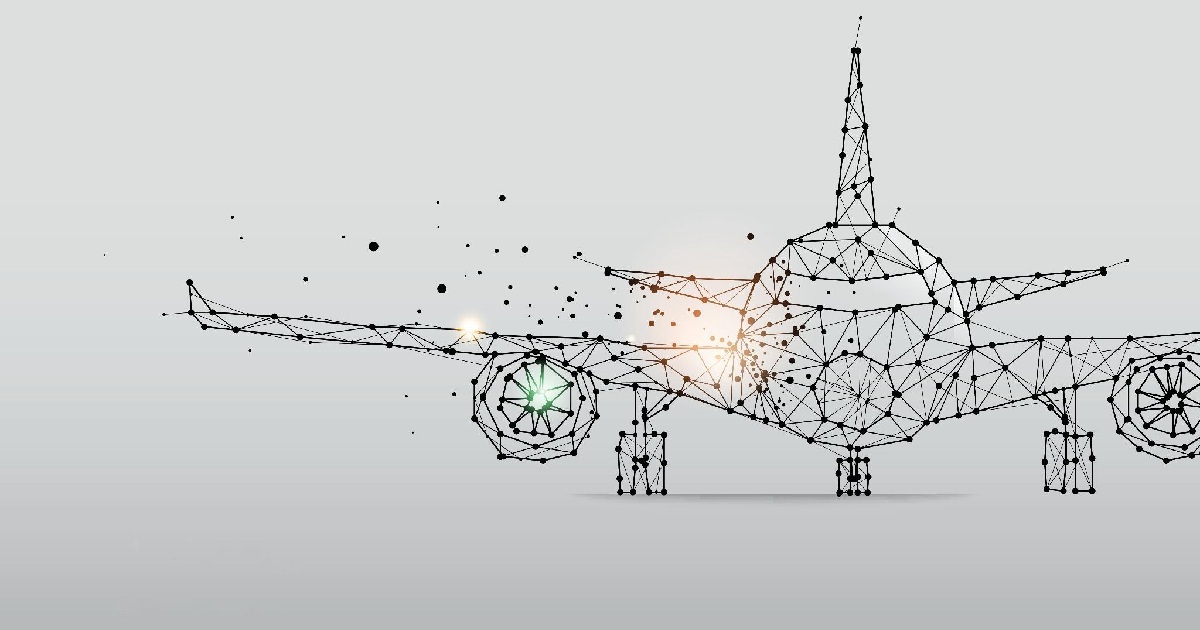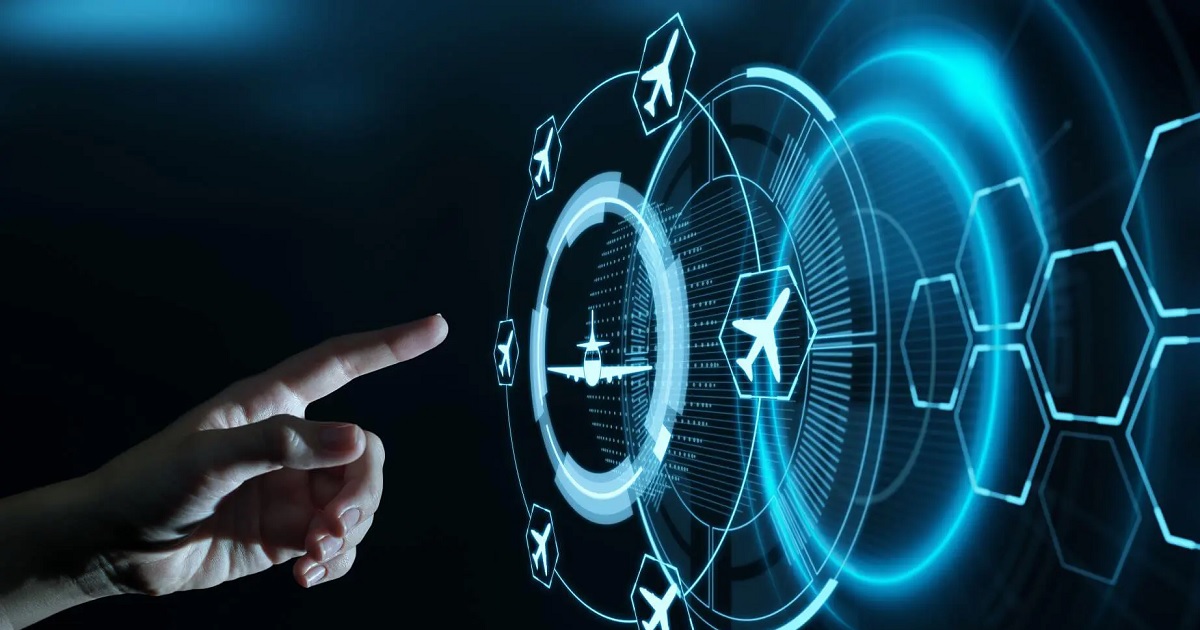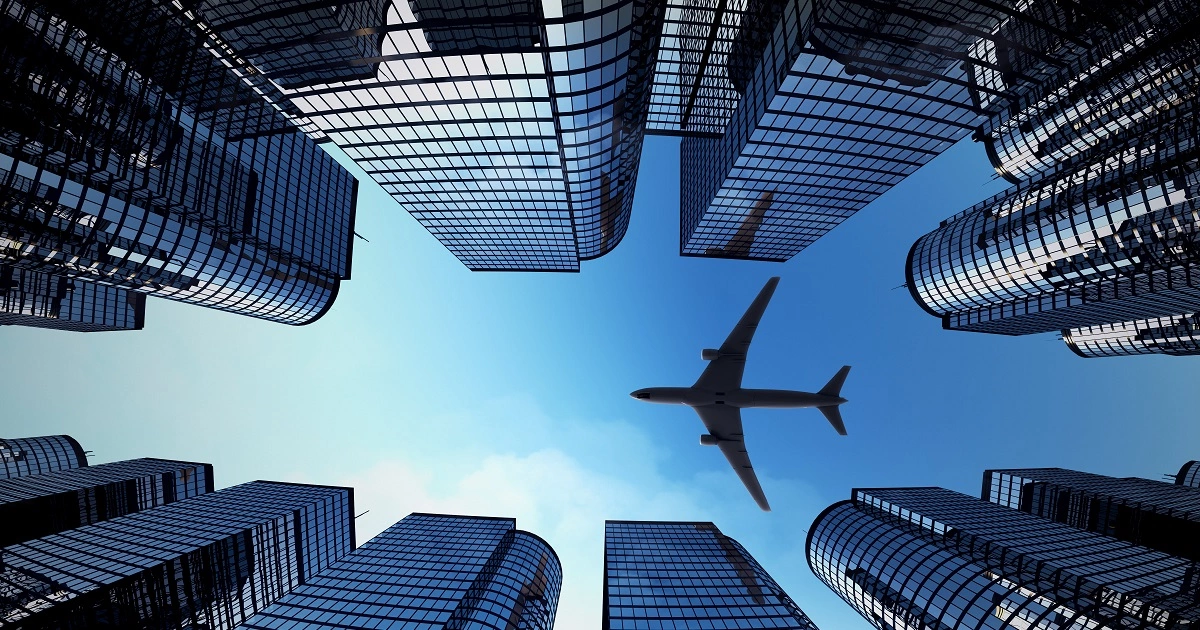
Business Aviation
Article | January 28, 2022
Each year airlines begin new sustainability initiatives, experiment with biofuels, and offset their carbon emissions on selected flights; yet, sustainability should not only be a topic of discussion when an aircraft is in the air but also when it’s on the ground.
In just one year, a Boeing 777, 787, Airbus A330, and A350, burn an extra 265,000 litres of fuel due to the 1% increase in drag. As a result, a full year’s operations of such an aircraft costs US$77,600 more than during the previous year. A dirty aircraft exterior is full of microscopic patches of dust and mud that impact the airliner’s operational efficiency by creating turbulent airflow across the whole fuselage. While the problem of additional drag is not new, there are no solutions to combat it other than performing regular cleaning of the aircraft’s exterior.
Reducing drag – through cleaning – on aircraft fuselage, wings, engine cowlings, and stabilizer brings another challenge; how to remain sustainable while performing the exterior cleaning process? A popular, yet wasteful pressurized water cleaning technique requires more than 11,300 litres of water to clean one Airbus A380 aircraft and more than 9,500 litres to clean a Boeing 777. Traditionally, aircraft are cleaned four to five times per year, and with more than 48 thousand airframes in the world, the amount of water used each year is immense. As a result, the positives of clean fuselages are outweighed by the negatives of wasteful usage of expensive and environmentally important resources.
This raises a question: whether it is possible to be eco-friendly in the aviation industry when one solution brings even more challenges than benefits? While the answer may look complicated, the definite answer is yes. The use of robots in household applications has proven that robotification is an inevitable and much-needed process to achieve even more efficient operational performance.
One of the solutions to address the inefficient and time-consuming process of washing an aircraft fuselage is to employ an aircraft exterior cleaning robot. The market offerings like Nordic Dino, have been perfected and adapted to work with a wide range of aircraft fuselage types. Such robots are designed to minimize the use of water and detergent on every wash; saving more than 30% more water when compared to traditional washing methods. At the same time, built with sustainability in mind, the robots can be equipped with electric motors, further minimizing the environmental impact.
“Sustainability and eco-friendliness should not be viewed as challenges or impossible achievements in the aviation industry. By utilizing the right equipment, finding alternatives to polluting methods, and increasing efficiency at every step possible, companies could come one step closer to operational efficiency as well as sustainability targets. Our offering, Nordic Dino can reduce the use of water and detergent and can be powered by electricity, reducing carbon and nitrogen dioxide emissions. By the robotification of the cleaning process we present a solution to MROs and dedicated aircraft cleaning companies to become green.” – commented Jan Brunstedt, CEO of Aviator Robotics AB.
Read More

Air Transport
Article | July 15, 2022
Is the aviation industry finally reviving after the devastating 2020? If yes, then what will it show in the next five years?
2020 will be remembered in airline history as the most turbulent year to date. Due to the pandemic, the period brought massive changes in the airline industry—business models and customer behavior globally. As a result, regaining customer confidence and reforming business models have become a critical factor for airlines to uncloud the economic storm and remain a formidable competitor in the years of uncertainty ahead.
Technologies that were being used before the pandemic are now being studied well with vividness. The inclusion of new technologies is onboarding, which somehow sets up new aviation industry trends. These will be a timely solution to fight the ongoing economic instability and challenges pouring in.
To increase safety notions, boost business confidence, customer trust, and making airline operations more efficient, adaptability and high intelligent business outline is the new blueprint for survival and growth to happen in the next five years.
Drivers of Emerging Trends
The intention of emerging trends in the airline industry is from weak signals from a wide range of fields, including threats, technology, and potentiality to function remotely, impacting the industry’s all-over operational dynamics.
The trends are setting primarily due to the winds of change pounding the industry from different directions. Be it from technological, demographical to environmental shifts. Understanding the potential business landscape is therefore critical to ensure what the future of air travel will be.
During a study conducted by IATA, business leaders in the airline industry identified the most critical drivers of emerging trends that were probable to have an influential impact by 2035. Also, these drivers suggest bringing more and more opportunities in business models and operational models of the industry beyond 2020.
Therefore, it is the hope of all airline companies (you) that how you will be affected by future developments and how the entire business landscape will be changed by the trends discussed here. So, take advantage of the opportunities that some of these trends may give rise to.
Leading Aviation Trends to Expect
Cybersecurity
Today, the importance of cybersecurity technology in the airline industry is rising. Airlines, now being aware of the downsides of using traditional operational models, is becoming more concerned about delivering high-performance using technology.
With having well-operated cybersecurity functionality onboard, airlines are focusing on becoming more agile to scale their infrastructure. Also, in the next five years, increased connectivity between the real and virtual world, including robots, will eventually end the boundaries between virtual and physical security.
IATA’s research with the London School of Economics found that the aviation industry will invest $15 billion by 2035, thanks to connected operations.
Moreover, as cybersecurity matures, it will be seen as the most secure and scalable way of operating organizational data, and processing will be easier than before. You will have your airline documents within a secured centralized database, which will reduce silos of information that pose security risks and threats.
Biometric Technology
The pandemic, apart from bringing challenges, has helped businesses to leverage influential ideas to foster. Yes, it has made the airline industry emphasize the high usage of biometrics as a must-have technology stack. Biometrics is on the rise that can reinforce the idea of touchless operations in airports.
The airline industry forecast has laid primary focus on self-service. However, as the blend of software and technology is more in demand, applications will be more defined than before in the coming five years. The technology will allow automated checks, self-service systems using devices like mobile, tablets, and others and cover iris, face recognition, fingerprint, which will even work with PPE masks.
The industry is already making great experiences that allow businesses to conduct frictionless operations using biometric software and hardware. For example, in November 2020, Star Alliance introduced a novel interoperable biometric identity scanner platform for screening employees and passengers at airports.
AI & Big Data
Artificial Intelligence (AI) welcomed massive opportunities in transforming aviation business operations amid the ongoing crisis. This technology in the airline industry has immensely aided companies in collecting data and forming a virtual assistance environment for queries, enhanced logistics operation, security, and self-services with highly augmented reality.
A market survey reveals that 97.2% of the aviation companies are installing big data and AI together. In fact, 76.5% of airline companies are gaining the value of data collection with the help of big data and AI. Source: resources.vistair.com
AI is also being set up in terms of safety improvement initiatives and potential safety issues. In this case, Southwest Airlines partnered with NASA to build an automated system capable of preventing potential threats and breaches by using machine-learning algorithms.
Green Technology
Green technology is one of the upcoming trends in the airline industry in the next five years. The prediction is it will make novel changes in the airline industry from various directions like the workforce, shares, stakeholders, and governments.
In the green tech concept, it is the generational shift and advancement that may head the change using new tools. These would bring in notable opportunities beyond 2021.
If you observe, the pandemic has driven the agenda of sustainability in terms of climatic conditions. And you will be surprised to know that aviation has already put up a serious concern in its fossil fuel usage by 2035. Even aircraft manufacturers have begun their journey with green technology.
To clarify this, the main objective of sustainable development for the coming years is decarbonization and green technology investment.
Aviation companies like Japan Airlines and IAG are investing to bring net-zero carbon emissions by 2050, and by 2045, they aim to achieve carbon neutrality. And these, of course, are happening quickly due to digitalization.
Expecting a Sustainable ‘DIGI-TECH’ Future
As the pandemic brought downturn and slowdown in the airline industry, they have prioritized investing in digital by recognizing its importance and the optimum necessity. It is because it will be one of the significant ways for you to bring customers back and show your potential to endeavor services in a changing industry landscape.
So, technology and digital together must be supported that respects businesses’ need to invest in multiple areas of functionality. On the other side, revenue management goals also need to be focused on to gain success among competitors. And following the path of trending digital platforms will make you victorious over revenue management performance objectives. In this way, you will be in the skin of the game and would observe your company rising through the challenges over the coming years.
Frequently Asked Questions
What are the topmost technologies that will define aviation beyond 2021?
The technologies—3D printing in manufacturing, automation, and robotics are the topmost that will define how the aviation industry will be beyond 2021.
How is technology being used in aviation?
Airline operators use technology to market their services and products, advancing their software to leverage functionalities like biometrics, automation, cybersecurity, AI, big data, and more. Also, technology is being used to make safer airport operations like touchless checks to make safe for passengers.
Will the aviation industry overcome challenges?
Up until now, globally, the aviation industry is maintaining positive growth, despite prevailing challenges due to COVID-19. Technologically, it seems that the industry will foster slowly and gradually. Yet, there is sluggish growth economically due to high jet fuel prices.
{
"@context": "https://schema.org",
"@type": "FAQPage",
"mainEntity": [{
"@type": "Question",
"name": "What are the topmost technologies that will define aviation beyond 2021?",
"acceptedAnswer": {
"@type": "Answer",
"text": "The technologies—3D printing in manufacturing, automation, and robotics are the topmost that will define how the aviation industry will be beyond 2021."
}
},{
"@type": "Question",
"name": "How is technology being used in aviation?",
"acceptedAnswer": {
"@type": "Answer",
"text": "Airline operators use technology to market their services and products, advancing their software to leverage functionalities like biometrics, automation, cybersecurity, AI, big data, and more. Also, technology is being used to make safer airport operations like touchless checks to make safe for passengers."
}
},{
"@type": "Question",
"name": "Will the aviation industry overcome challenges?",
"acceptedAnswer": {
"@type": "Answer",
"text": "Up until now, globally, the aviation industry is maintaining positive growth, despite prevailing challenges due to COVID-19. Technologically, it seems that the industry will foster slowly and gradually. Yet, there is sluggish growth economically due to high jet fuel prices."
}
}]
}
Read More

Business Aviation
Article | December 28, 2021
The COVID-19 effect has been tendered on business aviation than commercial aviation. However, it is the operations that reported a surge in demand for business aviation. The demand has been witnessed from new businesses and and those who revamped their operations amid travel restrictions.
In 2020, the airline industry experienced a heavy loss of worth USD252 billion, reports IATA. The industry players were at risk, which included accounting with direct economic destruction. Prompted by other risks factors such as restrictions on movements, especially travel limitations due to COVID-19, there is a serious need for the industry to access its operations competently.
So here are two crucial questions that took the heat. First, how is the industry going to manage economic uncertainties, travel restrictions, and market instability? And second, how may these affect aviation business conclusions in the coming years?
Such considerations may include some crucial aspects. They are changes in valuation methods, revision of future investments with existing liabilities, re-assessment of forecasted fuel consumption, revision of manufacturing, marketing, and others.
This blog is aimed at capturing the impact of COVID-19. And how business aviation can proceed to bridge gaps across multiple travel restrictions, both during and after the COVID-19 crisis. To delve into detail, let's go further.
The Level of Airline Business Drop and Recovery
Globally, the aviation businesses were severely harmed by 80% in 2020. The industry players found it extremely complex to navigate the commitments. Also, their work with collaborations is slated for the same year.
Customers seemed uninterested in discussing new business acquisitions due to COVID travel restrictions on business. However, some operators preyed on lower prices and increased demand for aviation services and products. These were mainly in the manufacturing and marketing fields. The reason is some corporate clients easily adapted to the emergence of digital platforms. They switched to zoom calls to replace personal contacts and connections.
Michael Walsh, CEO of Aer Mobi, says,
“OEMs have now announced a major drop in production capacity. Potential buyers could be from booming sectors financial services and online sales as they may seek to purchase high-profit products. These will be only a few brilliant spots for new aircraft purchases for OEMs.”
On the same note, Shaun Quigley, Managing Director, Volantair Air Charter, says
“In the time of crisis, the ability is to “pull one’s head in." This is what will happen at least until the final quarter of 2021.”
Business aviation in 2021 will hover around 25% to 30% globally, says Jose Rego, Senior Director – Market Intelligence and Strategy, Embraer Executive Jets. The rebound will be sluggish until 2025.
While the travel businesses' situation in the pandemic is not up to mark, its believed that digital transformation is viable to conduct airline operations. Such transformation will drive sales eventually following the rise of trending technologies simultaneously.
Aviation Business by 2030
A major transformation is promised by an array of powerful new technologies and corporate clients’ pressure. The industry plays that turn this trend to their advantage have the opportunity to redefine, restructure, reform, and reshape their business amid air travel restrictions.
So how will the key players of the aviation sector take their businesses forward by 2025 and beyond? Here is the outline of vital forces that the sector will see transforming.
Robotics Maintenance
Currently, airline operations maintenance accounts for approximately 20% of the operating costs. However, as the pandemic happened, market players and novel inventions are placing big hopes on the intelligent automation of maintenance.
For example, Airbus uses two seven-axis robots on the new fourth A320 line in Hamburg to conduct 80% of their business operations, thus improving functional aspects for employees.
Intelligent automation is fueled by terabytes of data. The data could be stored and used by businesses to manage operations easily. The addition of robotics and AI in aviation has increased the digitalization shift landscape for established players. From automatic scanning, data mining to improved diagnostics, robotics has a significant role in the future of aviation operations and maintenance.
Use of Alternative Sources of Energy
The shifting of environmental sentiments has made the aviation industry include greenhouse gases, electrofuels, hydrogen, and even batteries. The industry has set a target of cutting down high energy emitter fuels by half by 2030.
Companies like Airbus have impressive plans to develop hydrogen planes in the next 15 years. Even for eleven years, SkyNRG has been known for supplying "advanced waste" biofuels to airlines. These fuels are recycled from industrial waste, cooking oil, agricultural and forestry residues.
New technologies from engineering and manufacturing of aerodynamic are going to play a significant role in upcoming airline trends like specialized and improved designs and the use of carbon-efficient biofuels and electric
In this case, the International Council on Clean Transportation (ICCT) research found out that around 5.5% of aviation fuel could come from sustainable origins by 2030. Basically, it would be primarily from advanced waste biofuels.
Aviation Business: Witnessing Some Hope
There is an anticipation that the established aviation businesses will pick up their pace by 2022 amid COVID 19 restrictions.
Interestingly, there has been a pick up in air travel (essential air travel) in a specific part of the world. However, in some Asian countries, travel activity is estimated to be less than 40%. But the travel demand is expected to be higher in the years ahead.
Aviation business operators expect expanded business with new criteria of sales—digital. They might witness growth due to new prospect acquisitions that have adopted the digital workforce. The businesses expect green shoots of growth in the travel industry. Especially from business travel classes as these are seeking to experience fly again.
Business aviation traffic in 2021 highlighted the growing interest from buyers. On this, Jose Rego, Senior Director – Market Intelligence and Strategy, Embraer Executive Jets elaborates,
“There may be a peripheral surge in demand from first-time buyers; I expect this to affect fractional sales initially.”
Therefore, now IATA estimates that governments globally will provide $160 billion in support, loans, and tax breaks so that airline businesses can cover current costs.
Safety is Priority, so is Business
The aviation industry acclaims that business aviation might be on track sooner. In this context, the presence of a qualified team and fast-track applications, software, and platforms could help operators to function in a safe and well-maintained way.
As the aviation industry continues to plan new air travel rules (essential), aviation business is at an optimum point. Its crucial role in supplies, sales, business development, and essential air travel services has redefined the face of business. Thus, in this way aviation business has paved the way to make a strong comeback in the coming years.
Frequently Asked Questions
What can future measures due to the pandemic suggest for the aviation industry?
Airline businesses must have a robust plan which establishes the core of business aviation. The future is for market leaders. How they will manage roles and responsibilities responding to the crisis. Finally, national authorities will have a crucial role in stimulating demand and fostering the rapid recovery of the airport business. Restoring consumer confidence will be an essential part of this effort.
What is the COVID-19 advice for the aviation industry?
The global market leaders are actively managing the impact of COVID-19 to ensure aviation safety and to support the industry’s return to normal safety assurance activities. They have put efforts on surveillance approach on every business operation to increase accuracy by introducing technologies.
{
"@context": "https://schema.org",
"@type": "FAQPage",
"mainEntity": [{
"@type": "Question",
"name": "What can future measures due to the pandemic suggest for the aviation industry?",
"acceptedAnswer": {
"@type": "Answer",
"text": "Airline businesses must have a robust plan which establishes the core of business aviation. The future is for market leaders. How they will manage roles and responsibilities responding to the crisis. Finally, national authorities will have a crucial role in stimulating demand and fostering the rapid recovery of the airport business. Restoring consumer confidence will be an essential part of this effort."
}
},{
"@type": "Question",
"name": "What is the COVID-19 advice for the aviation industry?",
"acceptedAnswer": {
"@type": "Answer",
"text": "The global market leaders are actively managing the impact of COVID-19 to ensure aviation safety and to support the industry’s return to normal safety assurance activities. They have put efforts on surveillance approach on every business operation to increase accuracy by introducing technologies."
}
}]
}
Read More

Air Transport
Article | July 15, 2022
NASA is known for developing and launching spacecraft that have a significant environmental impact. However, the space agency is fully on board with the net-zero movement. NASA supports the White House's Aviation Climate Action Plan. It is helping fund several aviation projects that aim to reduce the aviation industry’s damage to the environment.
NASA’s Sustainable Flight Demonstrator Program
NASA focuses on technologies for single-aisle aircraft, which are the powerhouses of many airline fleets and account for nearly half of global aviation emissions. NASA's Sustainable Flight Demonstrator (SFD) project aims to reduce carbon emissions and keep the US competitive in the design of single-aisle commercial airliners, which are in high demand.
"Since its creation, NASA has worked with industry to develop and implement innovative aeronautics technology and has shared it with the world," said NASA Administrator Bill Nelson. "Now, with this ambitious new project, we're again joining with US industry to usher in a new era of cutting-edge improvements that will make the global aviation industry cleaner, quieter, and more sustainable."
NASA Wants to Reduce the Environmental Impact of Commercial Aircraft
The program’s goal is to build, test, and fly a large-scale demonstrator. NASA hopes to find a business partner for a Funded Space Act Agreement with its Armstrong Flight Research Center in Edwards, California, by the beginning of 2023.
The agreement would draw on private-industry knowledge and experience, with an awardee developing a suggested technical plan and committing considerable cash to the project. Under this agreement, NASA would not purchase an aircraft or any other hardware for its missions. The mission of NASA is to develop new and innovative technologies and capabilities.
NASA will collect data on the ground and in the air. Agency and industry teams can use it to test the airframe configuration and related technologies.
Moving Away From Space
NASA's technologies are typically cutting-edge. However, as with many high-end items, the benefits and applications frequently filter down to the masses. NASA's specialized technology and research frequently has civil aviation applications. It's interesting to see how NASA seems to be moving away from space and going after planes that fly closer to Earth.
Read More